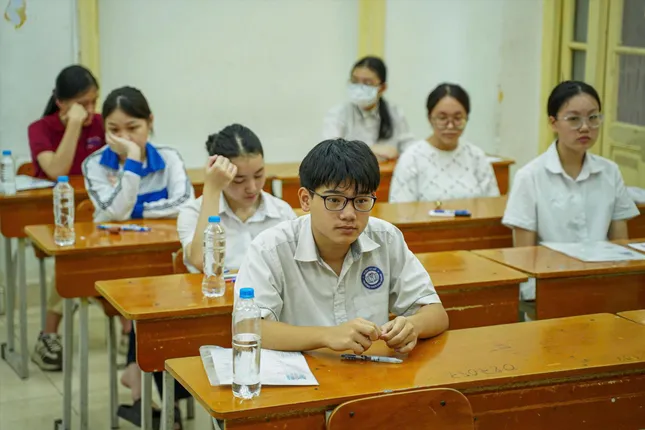Not only weak students go to vocational school.
Dr. Dong Van Ngoc, Principal of Hanoi College of Electromechanics, said that the notion that students with average/weak academic performance should not take the 10th grade exam and should go to vocational school is wrong. Because not all weak students go to vocational school. Many vocational training institutions currently have very high admission standards, with students achieving high school graduation exam scores of over 27 points.
Career orientation is to help students see the future and how to study to suit their abilities, strengths, and passions is the student's choice.
 |
Hanoi students take the 10th grade entrance exam. Photo: NGUYEN DUC |
According to Mr. Ngoc, career counseling and guidance need to be more practical, more specific, and more experienced. Career guidance and guidance are currently not systematic, continuous, and late. In many countries around the world , students are oriented and experience careers very early in life in many different forms and not according to targets or plans.
According to Mr. Ngoc, the establishment of targets and plans for student streaming after secondary school is a policy orientation. The important thing is how to implement it? Each school needs to build a career orientation and counseling program early, coordinate with parents, and create a space for students to experience.
According to the recently issued Education Development Strategy to 2030, with a vision to 2045, the transition rate from primary to secondary school reaches 99.5%, from secondary to high school and other levels reaches 95%. Thus, the Government no longer sets the vocational training rate after secondary school at 30-40% as in the previous period.
According to the reporter's notes, the 2006 program "skipped" the career counseling part, the 2018 program paid attention to this issue but in the new design only devoted a certain number of periods to career counseling.
Students learn in a "passing by" way or some schools do not pay attention so it is difficult to "absorb". Only in some non-public high schools, career guidance and streaming are carried out consistently, continuously and with a process appropriate to each stage of the student.
Associate Professor Dr. Tran Thanh Nam, Vice Principal of the University of Education (Hanoi National University) affirmed that there should not be a "hard" quantitative quota in the stream after junior high school and high school. Students' further education depends on the capacity of learners in each locality, the quality of vocational education or vocational education support policies, it is difficult to depend on the will of those implementing the policy.
“If applied rigidly, it can lead to problems. In fact, there have been cases where teachers in some schools have encouraged students with poor academic performance not to take the entrance exam to public high schools,” said Mr. Nam. Mr. Nam proposed that it is necessary to specify the regulations in the framework of the national education system; clarify the “streams” that junior high school graduates can study to develop sustainable careers. Ensure connectivity between training programs.
Next, it is necessary to strengthen labor, employment and salary policies, career development opportunities for workers at the vocational education level. Improve the quality of career education and implement career counseling and career experiences for students early so that they can soon understand their own abilities and the world of careers, the labor market, and paths after junior high school, high school, etc.
Must ensure 100% of study places for students
According to the recently issued Education Development Strategy to 2030, with a vision to 2045, the transition rate from primary to secondary school will reach 99.5%, from secondary to high school and other levels will reach 95%. This strategy will take effect from 2025. Thus, the Government will no longer set the vocational training rate after secondary school at 30-40% as in the previous period.
Minister of Education and Training Nguyen Kim Son shared about the process of building the strategy in the past 2 years, in which the Ministry of Education and Training has repeatedly sought opinions from ministries and branches on each indicator of the strategy. Regarding the rate of streaming after junior high school, the head of the education sector said that there is currently no convincing basis for this rate.
The basis for streaming and career guidance is based on students' voluntary needs, and the State must guarantee 100% of school places for students. At the same time, it is necessary to clear the ratio of streaming and career guidance for localities to ensure adequate investment in schools and classes.
The Ministry of Education and Training said that it is currently seeking comments on a draft Decree regulating career guidance and streaming in education. The principles of career guidance and streaming in education include factors such as ensuring harmony between students' aspirations and abilities with socio-economic development trends and human resource needs of the country and localities in each period.
Ensure the right to career orientation and respect for students' choice of study and career. Career orientation and streaming in education must be systematic and continuous.
Career guidance activities need to diversify the forms of practical experiences and integrate them into education and training programs; career guidance and streaming must go hand in hand with ensuring quality and connection between education and training streams... The responsibility of the People's Committees of provinces and cities is to determine the streaming ratio according to the guidance of the Ministry of Education and Training.
In particular, localities must ensure that 100% of junior high and high school students have access to professional career guidance and counseling services; at least 20% of learners aged 15-25 attend vocational education; the transition rate from junior high school to high school and other levels must reach at least 95%.
Benefits of removing the imposition of streaming quotas
Ms. Nguyen Thi Mai Hoa, Vice Chairwoman of the National Assembly's Committee on Culture and Society, said that without being imposed with streaming quotas, schools will not chase after achievements and will better control extra teaching and learning. Localities that are not imposed with streaming quotas will prioritize opening schools to meet students' learning needs.
Ms. Hoa believes that the orientation of the stream is aimed at the goal of training human resources suitable to the needs of socio-economic development. However, the efficiency of the stream is generally very low.
According to the Ministry of Education and Training's report, the national average rate of student streaming after junior high school is 17.8%. Some localities only achieve less than 12%; far from the Government's target of having at least 40% of junior high school graduates train at elementary and intermediate levels by 2025 (localities with particularly difficult socio-economic conditions must achieve at least 30%).
 |
There are no longer any streaming quotas, junior high school graduates are guaranteed the right to access high school education. Photo: HOANG MANH THANG |
With this result, the target of streamlining was not achieved, including the criterion of "increasing workers, reducing teachers" according to the human resource requirements to serve socio-economic development.
This has led to a number of educational shortcomings such as the increasing pressure of the 10th grade entrance exam, the widespread situation of extra tutoring and learning, increasing the costs parents have to invest in their children to compete for a place at public high schools.
“In my opinion, the nature of student streaming after junior high school is to guide learners to choose a path that suits their abilities, strengths, aspirations, and circumstances; at the same time, it is also suitable for the human resource requirements of society and the economy, contributing to adjusting the structure of training levels and occupations,” Ms. Hoa expressed.
Fortunately, the Education Development Strategy to 2030, with a vision to 2045, only sets the target of achieving 95% of students from junior high school to high school and other levels, and no longer sets the rate of vocational training after junior high school as in the previous period.
According to Ms. Nguyen Thi Mai Hoa, to successfully stream students after secondary school, localities are responsible for ensuring that schools meet students' learning needs, including the system of general education facilities and quality vocational education facilities. The State needs to have policies on labor and employment, salary policies and other policies for workers through vocational training; closely linking vocational education with the actual needs of the labor market, solving the imbalance between supply and demand, improving the quality of human resources to meet the requirements of the country's socio-economic development and international integration.
Source: https://tienphong.vn/se-khong-khong-che-ti-le-hoc-sinh-vao-lop-10-cong-lap-post1758902.tpo


![[Photo] General Secretary To Lam chairs the meeting of the Central Steering Committee on preventing and combating corruption, waste and negativity](https://vphoto.vietnam.vn/thumb/1200x675/vietnam/resource/IMAGE/2025/9/29/fb2a8712315d4213a16322588c57b975)
![[Photo] General Secretary To Lam receives US Ambassador to Vietnam Marc Knapper](https://vphoto.vietnam.vn/thumb/1200x675/vietnam/resource/IMAGE/2025/9/29/c8fd0761aa184da7814aee57d87c49b3)
![[Photo] General Secretary To Lam attends the ceremony to celebrate the 80th anniversary of the post and telecommunications sector and the 66th anniversary of the science and technology sector.](https://vphoto.vietnam.vn/thumb/1200x675/vietnam/resource/IMAGE/2025/9/29/8e86b39b8fe44121a2b14a031f4cef46)
![[Photo] Many streets in Hanoi were flooded due to the effects of storm Bualoi](https://vphoto.vietnam.vn/thumb/1200x675/vietnam/resource/IMAGE/2025/9/29/18b658aa0fa2495c927ade4bbe0096df)
![[Photo] National Assembly Chairman Tran Thanh Man chairs the 8th Conference of full-time National Assembly deputies](https://vphoto.vietnam.vn/thumb/1200x675/vietnam/resource/IMAGE/2025/9/29/2c21459bc38d44ffaacd679ab9a0477c)





















































































![[Infographics] An Giang tourism makes a spectacular breakthrough](https://vphoto.vietnam.vn/thumb/402x226/vietnam/resource/IMAGE/2025/9/30/e472f9f3f91d407ba4b7de460fb0481d)












Comment (0)